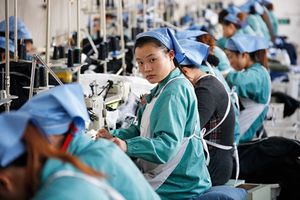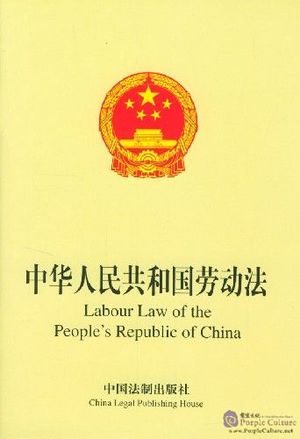Female Migrant Workers in China
Introduction
Female migrant workers, or in other words, “"Dagongmei,” refers to Chinese female workers with a rural household registration and are employed in an urban workplace. [1] Since the regulation on permanent residence registration was loosened in 1984, millions of Chinese rural residents have been migrating to the cities every year. Due to the effect this has on China’s potential economic and social aspects in Chinese society, [1] the number of migrant workers exceeded 98 million in 2003. Female workers usually come to Guangdong from poorer provinces situated within the Yangtze River region, such as Sichuan, Hunan, Hubei, Jiangsu and Jiangsi.[2] The household registration “Hukou 户口” system have been used to control migrants and manage taxation. [1] The majority of female workers originate from undeveloped areas and are not specialized in agriculture and farm work. While the proportion of women in the lower income group is higher than men, the proportion of female workers in the higher income group is lower. [3] This acts as a limiting barrier for women to obtain equal work opportunities. Despite the disadvantages and barriers dealt by Chinese female workers, their work performance remained effective. This demonstrates how women are playing important roles at the crossroads between the booming capitalist economy and the traditional rural society. [3]
Employment patterns and wages
The vast majority of rural migrant workers are still employed in low-salary jobs in manufacturing, construction, and services. [1]However, the percentage of migrants working in manufacturing has decreased from 36.7 percent in 2010 to 30.5 in 2015.The wage levels for migrant workers have increased over the past years, with the average wage stable at 3275 yuan. The highest pay sectors in 2016 for migrant workers were transport and logistics and construction. [1]
Causes Of Migration
Migration has been increasing in the past decades, where human beings have always moved in search of new opportunities, to escape poverty, conflict or land degradation.
Poverty
Despite the alteration of women’s status and roles in society, there are still disadvantaged rural women without basic rights, which strongly affects their living standards.[1]According to the official statistics, China’s population living beneath the poverty line has dropped from 250 million to 42 million, showing massive improvements over the recent decades[4] Thus, for the millions living below the povery line, poor living conditions with no access to basic services or amenities, as well as minimal wages are common and unavoidable.Poverty therefore is a strong push factor in changing work location. [3]
Support of Families
The transfer of money home, or in other words, “remittance,” refers to the money sent by migrants. This is a significant part of international capital flows. For many in rural areas, work opportunity is limited for themselves and for their dependables. Studies have found that it is very common for rural-urban migrants to send most of their wages back home to support their families, [3] including for the support of male siblings. Women are often seen as temporarily provider, offering economic benefits to their blood family before they integrate into a part of their husband’s family. [1]
Issues Among Female Migrants
There are numerous ongoing issues that is associated with the movement of individuals. Persistent inequality in wealth will continue to widen the wage gap in society and between nations.
Restricted Benefits
Female migrants are considered as minorities in urban cities in China. Despite the need and desire for high economic growth from a wider development perspective, [5] they are not legally recognized as the city resident, resulting in the lack of provision of standard government services, such as healthcare and labour laws. In spite of their willingness to take on “undesirable” jobs, migrant workers are not entitled to subsidized housing, education, social security and medical benefits.[2] Furthermore, Chinese female migrants fail to receive social security premiums as they are essentially needed for residents instead. Health and insurance plans for the workers are poor since the majority tends to live in unsanitary and overcrowded dormitories.[4]
Psychological Well-being
As many female migrants live under poor living conditions, working overtime in questionable safety workplaces is standard. Only 19% of the female migrants had some form of health insurance, compared to 68% of the urban workers. [6] A study by Qiu Peiyuan looked internally at migrant workers, focusing on their psychological health and the symptoms associated with depression. The findings demonstrate a higher prevalence of depressive symptoms among migrant workers, compared to the general population. [7] This shows how many still lack emotional and psychological support needed for a healthy upbringing.
Discrimination
Each city in China handles their migrant workers at their own discretion, typically resulting in lacking social policies and only minor alterations made to prevent prejudice and discrimination towards migrants. Although female migrant workers are the main labor force driving economic growth in China, they are typically blamed for social disorder and crimes. Additionally, rules and policies often discriminate against migrant workers, where the legislative system still refuses to guarantee their labor’s quality of life and job security.[2] Health and social benefits are often refused as the demand for employment is increasing while provided with fewer benefits. Moreover, job discrimination is also present, forcing female migrant workers to take unwanted lower pay jobs compared to men in the competitive market.[1] Therefore, it is not common for migrants to experience unpleasant social encounters, widening the social gap between female migrant workers and local residents.[5]
Health and Safety at Work
Safety in the workplace focuses on the prevention of hazards. Health has been defined as “a state of complete physical, mental and social well-being and not merely the absence of disease or infirmity."[8] The working conditions and health status in rural-to-urban migrants have been explored, where many migrants have reported to at least suffer from an acute illness, chronic disease, and disability of some kind.[6]In 2002 report stated that over 14,000 workers have died in a total of 13,960 accidents and the manufacturing industry alone. [1]Females workers are exposed daily to unsafe working conditions, where machines are left unchecked without safety guards or constant exposure to toxic fumes in factories. These factories have often fail to provide medical coverage for their employees, despite the harsh working environments.
Labor Law Contract
The new Chinese Law contract enables workers to enforce their legal rights in which a written form of agreement would be handed out. China in the past decade had put economic growth and capital interests above the migrant worker’s psychological, social and physical well-being. [9] This contract will ensure all workers are legally paid covering both monthly and overtime wages. The increase in contract coverage had made significant changes to social insurances which are now being covered improving the positions of workers in China. [9]
References
- ↑ Jump up to: 1.0 1.1 1.2 1.3 1.4 1.5 1.6 1.7 1.8 Dagongmei’ - Female Migrant Labourers .” "Dagongmei" - Female Migrant Labourers , 8 Mar. 2004, www.clb.org.hk/en/content/dagongmei-female-migrant-labourers. http://clb.org.hk/content/dagongmei-female-migrant-labourers
- ↑ Jump up to: 2.0 2.1 2.2 Ye, Zhang. “Migrant Women Workers and The Emerging Civil Society in China.” Migrant Women Workers and The Emerging Civil Society in China, pp. 1–9.
- ↑ Jump up to: 3.0 3.1 3.2 3.3 LUO, GUIFEN. “ Chinas Rural-Urban Migration: The Structure and Gender Attributes of the Floating Rural Labor Force.” Chinas Rural-Urban Migration: The Structure and Gender Attributes of the Floating Rural Labor Force., vol. 42, 2006, pp. 65–92.
- ↑ Jump up to: 4.0 4.1 Wong, Daniel Fu, and He Xue Song. “ The Resilience of Migrant Workers in Shanghai China: the Roles of Migration Stress and Meaning of Migration .” The Resilience of Migrant Workers in Shanghai China: the Roles of Migration Stress and Meaning of Migration , vol. 54, no. 2, 1 Mar. 2008, pp. 131–143.
- ↑ Jump up to: 5.0 5.1 Wong, Daniel Fu, et al. “1. Rural Migrant Workers in Urban China: Living a Marginalised Life.” 1. Rural Migrant Workers in Urban China: Living a Marginalised Life, vol. 16, no. 1, 12 Dec. 2006, pp. 32–40..
- ↑ Jump up to: 6.0 6.1 Hesketh, Therese et al. “Health Status and Access to Health Care of Migrant Workers in China.” Public Health Reports 123.2 (2008): 189–197. Print.
- ↑ Qiu, Peiyuan et al. “Depression and Associated Factors in Internal Migrant Workers in China.” Journal of affective disorders 134.1-3 (2011): 198–207. PMC. Web. 7 Apr. 2018.
- ↑ "WHO Definition of Health". World Health Organization. World Health Organization. Archived from the original on 2016-07-07.https://en.wikipedia.org/wiki/Occupational_safety_and_health
- ↑ Jump up to: 9.0 9.1 Richard Freeman, and Xiaoying Li. “ Has China’s New Labour Contract Law Worked?” Has China’s New Labour Contract Law Worked?, 22 Dec. 2013, voxeu.org/article/has-china-s-new-labour-contract-law-worked.


